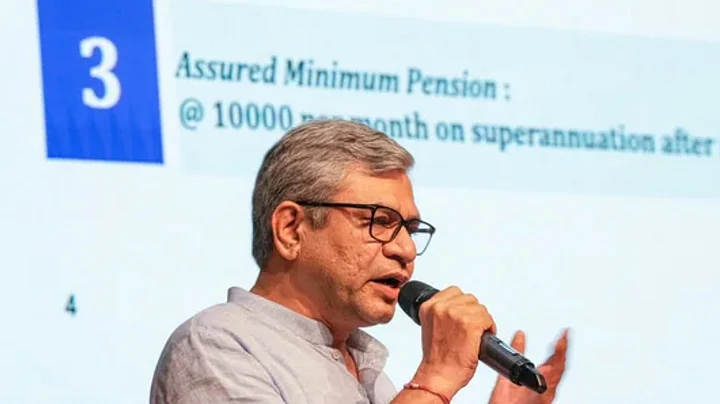On 24 August, the Union Cabinet approved the Unified Pension Scheme (UPS), effective from 1 April 2025, providing government employees with assured pension post-retirement. The scheme shall be applicable for those who retired under the New Pension Scheme (NPS) from 2004 onwards.
It is said that this was done in response to the backlash from government employees to the NPS, which came into existence on 1 January 2004, under the then Vajpayee government, replacing the Old Pension Scheme (OPS).
The NPS was quite different from the OPS in two basic ways. First, it had done away with the policy of providing an assured pension. Second, it would be funded by the employee himself/herself along with a matching contribution from the government.
The defined contribution comprised 10 percent (increased to 14 percent in 2019) of the basic salary and Dearness Allowance (DA) by the employee, and a matching contribution by the government.
Individuals under the NPS could choose from a range of schemes (from low risk to high risk) and pension fund managers promoted by public sector banks and financial institutions, as well as private companies. There were tax rebates on offer, too.
Under the OPS, pension to government employees, both at the central and state level, was fixed at 50 percent of the last drawn basic pay (like it is in the UPS). In addition, there would be a DA — calculated as a percentage of the basic salary — to adjust for the steady increase in the cost of living.
It is important to note that the NPS was introduced by the Vajpayee government because of a "fundamental issue" associated with the OPS, that is, it was unfunded and will ultimately balloon the nation’s fiscal deficit to unsustainable levels.
It was also argued then how, with better health facilities, the OPS will become unsustainable in the long run. As observed here: “Data shows that over the last three decades, pension liabilities for the Centre and states have jumped manifold. In 1990-91, the Centre’s pension bill was Rs 3,272 crore, and the outgo for all states put together was Rs 3,131 crore. By 2020-21, the Centre’s bill had jumped 58 times to Rs 1,90,886 crore; for states, it had shot up 125 times to Rs 3,86,001 crore.”
According to Union Information and Broadcasting Minister Ashwini Vaishnaw, the UPS has five key features:
Assured Pension
Assured Minimum Pension
Assured Family Pension
Inflation Indexation
Lumpsum Payment at Superannuation
The UPS announcement needs to be put in appropriate political and economic contexts. The scheme will have significant fiscal implications for a government that is already fiscally stretched and has a ballooning government debt-to-GDP ratio.
The limitations of the OPS have given way to a more pragmatic scheme, even though many states in recent years have returned to it (for example, Himachal in 2023, Rajasthan in 2022, Chhattisgarh in 2022, and Punjab in 2022). Most states returning to the OPS have been Opposition-run states – and the Bharatiya Janata Party (BJP) argued it was being offered as ‘revdi’ (freebies) to voters for electoral gains.
With the UPS now announced before critical state Assembly polls in Maharashtra, Haryana, and Jammu and Kashmir, where the BJP is on a weaker electoral standing and has a coalition at the Lok Sabha level, a similar argument could be said about its own position, that is, the UPS announcement is a political move aimed at electoral mobilisation of middle-class voters (it is no secret now that after Lok Sabha 2024, much of the middle class is upset with the BJP for its failed economic record).
On the economic implications of a return to an OPS-style pension scheme (which the UPS represents broadly despite having employee contributions), refer to this September 2023 bulletin which the Reserve Bank of India (RBI) published, cautioning and warning against the probable fiscal cost of reverting to the OPS for states embarking on that path.
A study, Fiscal Cost of Reverting to the Old Pension Scheme by the Indian States – An Assessment, undertaken in 2023 by the RBI's economists (Rachit Solanki, Somnath Sharma, RK Sinha, Samir Ranjan Behera, and Atri Mukherjee) had shown that if all states switch to the OPS in 2023, the cumulative fiscal burden could be as high as 4.5 times of the NPS, with the additional burden reaching 0.9 percent of the gross domestic product (GDP) annually by 2060. One can only imagine how bad this could be for Union finances under the UPS, which the Cabinet must clarify.
The Narendra Modi government, in its first 10 years of misgovernance and inconsequential economic policy making (demonetisation, the ad hoc implementation of GST, the ill-conceived farm laws, and pandemic-induced crisis responses, among others), had justified its policies on the sole reason of maintaining ‘fiscal consolidation’ or keeping its fiscal priorities in check. It brought down subsidies at precariously low levels and even cut essential social revenue expenditure on critical schemes in the name of maintaining ‘fiscal macro prudence’.
The UPS announcement now comes from a government that is less secure in its electoral positioning, lacking the ability to stand on its own words with respect to macro-fiscal priorities.
There are cracks developing in the BJP’s entitlement-driven welfare ideology that lacks critical reflection on areas where it should divert more focus like human capital development, empowerment, and higher social and economic mobility for the poor and marginalised sections of society.
(Deepanshu Mohan is a Professor of Economics, Dean, IDEAS, Office of Inter-Disciplinary Studies, and Director of Centre for New Economics Studies (CNES), OP Jindal Global University. He is a Visiting Professor at the London School of Economics, and a 2024 Fall Academic Visitor to the Faculty of Asian and Middle Eastern Studies, University of Oxford. This is an opinion piece and the views expressed above are the author’s own. The Quint neither endorses nor is responsible for them.)
